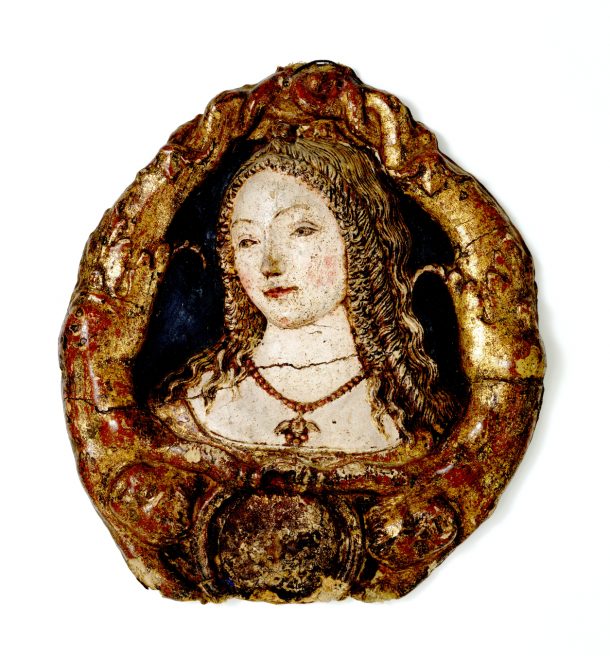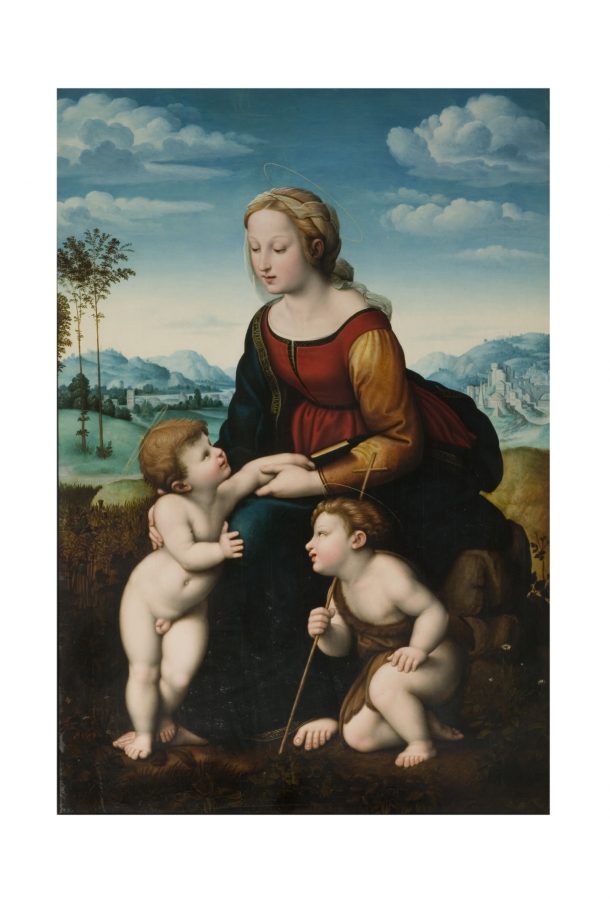There is a fascinating mirror, tucked away in a small glass cabinet on the top floor of The Foyle Foundation Gallery. I have always thought it is a rather inconspicuous place to display a glamorous object loaded with social commentary.

This remarkably preserved mirror frame was crafted from cartapesta (paper mâché), by Neroccio de’ Landi’s workshop. The frame itself is a sculpture of a woman, who flaunts a delicate necklace, luxurious ringlets and a demure expression. Her carefully constructed features suggest that she was a living person, she would have been an object of desire.
Mirrors were both a decorative and functional household item in the Italian Renaissance.1 They were a common marital gift, presented to the bride as part of her wedding trousseau2 – a thinly veiled insinuation that wives were expected to maintain a pleasing appearance as part of her marital duties.3 Funnily enough, the actual reflective surface is a tiny mirror embedded at the bottom of the frame. It is disproportionately overshadowed by the paper mâché face. I always chuckle, imagining how users of the mirror would have stared longingly at the artificial face in place of their own reflection.
In an era without Instagram models and haute couture magazines, these cartapesta mirrors popularised the most coveted features of a fashionable Italian Renaissance woman.4 Much like the YouTube tutorials that dominate today’s beauty empire, there were also the Books of Secrets. Household manuals that disseminated cosmetic recipes, teaching women how to bleach their hair and whiten their skin.5 These books were translated into English and published prolifically across Europe.6 As the literature travelled to different countries, so did the beauty ideals. Fair skin and golden hair became emblems of the wealthy, educated woman who had the free time to adorn herself.7
To learn more about Italian Renaissance cosmetic recipes, I recommend checking out: ‘Renaissance Secrets: Recipes and Formulas’ by Jo Wheeler, 2009, V&A Publishing.
A long tradition of Italian Renaissance art maintained the white woman as the female ideal. We only need to look at the golden tresses of Laura in Petrarch’s sonnets, the fair-faced Virgins of Raphael, to see that this was widely accepted as the norm.8 Agnolo Firenzuola famously declared in On the Beauty of Women that a woman with these features was not only beautiful, but also one with a good Christian soul.9 In other words, the white woman was the poster girl for the chaste maiden and the dutiful wife. The female face in de’ Landi’s mirror frame is more than just ornament. She represents the beauty standards that confined women to patriarchal constructs, enforcing how they were expected to dress and behave.

I remember reading Firenzuola and noticing how eerily similar his version of a ‘fair’ lady was to current-day beauty constructs. The same objectification of female bodies and the worship of whiteness has been reiterated to me in my everyday life, time and time again.
Here is a simple example. If you take a trip down to your local Superdrug or Boots, you will find that foundation shades sold by affordable cosmetic brands concentrate on the lighter end of the spectrum. The sparse selection of medium to dark shades rarely matches the actual colour tones of people with darker complexions.
This sends a subtle yet devastating message: white features are more desirable and offer advantages. Across the globe, the preference for whiteness seeps into our subconscious judgments. Studies find that African American women with lighter complexions are generally perceived as more well- educated and well-paid than their darker skinned counterparts.10 In some East and South Asian countries, such as Japan, Thailand and India, light skin is associated with wealth or auspicious marriage prospects.11 In the UK, surveys reveal that young people of colour regard lighter skin and racially ambiguous features as more attractive.12 In turn, the cosmetic industry feeds off the dissatisfaction that women of colour feel towards their natural-born appearance.13
The lucrative success of the skin-lightening industry is testimony to how white features have been commodified to primarily non-white women.14
The insidious seeds of misogynoir are sown far and wide. Racial biases take root in the structural inequalities of our societies. They fertilise colonial legacies that devalue people of colour. If we do not stop to question why white features are unanimously agreed to be beautiful, we continue to tell a white supremacist narrative. A colour-erasing, myth of self-hate that has been drip fed to people of colour. It misteaches us that white is the default.
This is only part of a vicious cycle. The supremacy of whiteness occludes people of colour from accessing leadership and public-facing positions.15 Without these role models, young people like myself are discouraged from imagining new possibilities for ourselves. Right now, we are deprived of the gatekeepers who might otherwise open doors for us. We cannot be empowered unless those already in power give us a seat at the table.
I still gaze upon de’ Landi’s mirror frame with curiosity. I imagine the women who must have stood before it, preening themselves but never able to attain the impossible standard of a perfect woman. Some things have remained the same since the Italian Renaissance, but unlike the women whose narratives have been silenced, we now have a voice. We are reclaiming our bodies as our home. Change has already begun, and it started with the woman in the mirror.
Want to hear more about upcoming events and opportunities for young people at the V&A? Visit the website and sign up for the newsletter for regular updates and news.
Sources and notes
Aisha Phoenix, ‘Open Space: Colourism and the Politics of Beauty’, Feminist Review, no. 108 (2014), pp. 97 – 105
Nadia Craddock, Ncoza Dlova and Phillippa C. Diedrichs. ‘Colourism: A Global Adolescent Health Concern’, Current Opinion in Pediatrics 30, no. 4 (2018), pp. 472 – 7
1 – Peter Thornton, The Italian Renaissance Interior: 1400 – 1600, London 1991 ↩
2 – Mary Rogers and Paola Tinagli. Women in Italy, 1350 – 1650: Ideals and Realities, Manchester 2005 ↩
3 – Sabrina Au, ‘“Mirror, Mirror, On the Wall”: Examining the Paradox of Beauty in Renaissance Italy’, MA diss., University of Edinburgh 2019 ↩
4 – Sabrina Au, ‘“Mirror, Mirror, On the Wall”: Examining the Paradox of Beauty in Renaissance Italy’, MA diss., University of Edinburgh 2019 ↩
5 – Girolamo Ruscelli, The Secrets of Alexis Containing Many Excellent Remedies against Diuers Diseases, Wounds, and Other Accidents, trans. William Ward and Richard Androse, ed. Early English Books Online, printed by William Stansby, 1615 ↩
6 – Thomas Jeamson, Artificiall Embellishments, or Arts Best Directions: How to Preserve Beauty or Procure It, ed. Early English Books Online, printed by Willian Hall, 1665 ↩
7 – Sabrina Au, ‘“Mirror, Mirror, On the Wall”: Examining the Paradox of Beauty in Renaissance Italy’, MA diss., University of Edinburgh 2019 ↩
8 – Agnolo Firenzuola, On the Beauty of Women, ed. and trans. Konrad Eisenbichler and Jacqueline Murray, Pennsylvania 1992, and Marta Ajmar and Dora Thornton, ‘When is a Portrait not a Portrait?’ in The Image of the Individual, eds Nicholas Mann and Luke Syson, pp.138 – 153, British Museum 1998 ↩
9 – Agnolo Firenzuola, On the Beauty of Women, ed. and trans. Konrad Eisenbichler and Jacqueline Murray, Pennsylvania 1992 ↩
10 – Kathryn Harper and Becky L. Choma, ‘Internalised White Ideal, Skin Tone Surveillance, and Hair Surveillance Predict Skin and Hair Dissatisfaction and Skin Bleaching among African American and Indian Women’, Sex Roles, 80 (2019), pp. 735 – 44 ↩
12 – Michael B Lewis, ‘Why are mixed-race people perceived as more attractive?’, Perception 39, no.1 (2010), p. 136 ↩
11 – Lester Davids, ‘Skin lightening: The beauty industry’s ugly billion-dollar secret.’ IB Times, 9 October 2017↩
13 – L. Hunter. ‘Buying racial capital: Skin-bleaching and cosmetic surgery in a globalized world.’ Journal of Pan African Studies 4 (2011), pp. 142–162. ↩
14 – Lester Davids, ‘Skin lightening: The beauty industry’s ugly billion-dollar secret.’ IB Times, 9 October 2017 ↩
15 – Karis Campion, ‘Diane Abbott and “misogynoir”: colourism, anti-blackness and sexism in the UK’, The Conversation, 1 February 2019 ↩


